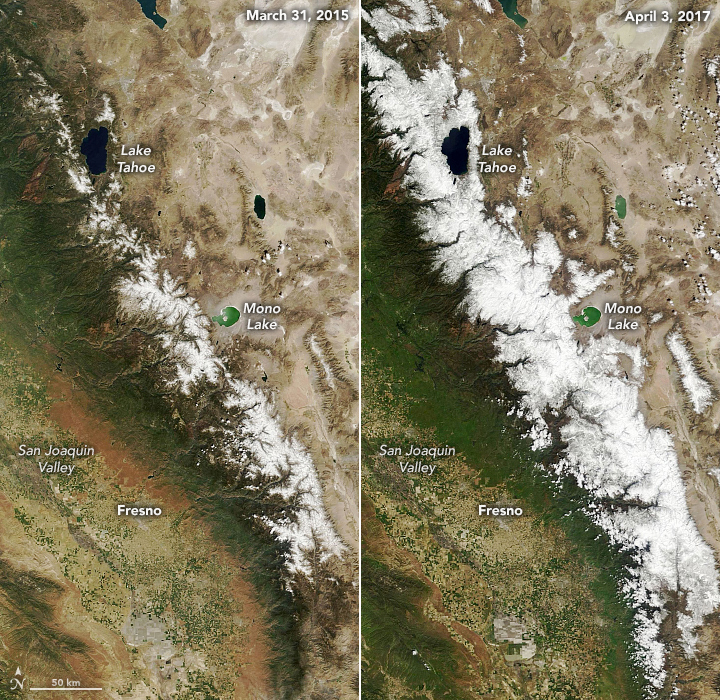


In Spanish, Sierra Nevada means “snowy mountain range.” While the term “snowy” has generally been true for most of U.S. history, those mountains have seen less snow accumulation in recent years. This decline plays a role in water management and response to drought in California and other western states.
Each spring and summer, meltwater runoff from Sierra Nevada snowpack helps replenish rivers and reservoirs, while also recharging the groundwater. In fact, snowpack accounts for about 30 percent of California’s water supply in a typical year, according to the California Department of Water Resources. About three-fourths of the state’s precipitation in an average year falls as snow and rain in Northern and Central California—mostly the Sierra Nevada.
The time-lapse series of images above shows springtime snow-covered area on the Sierra Nevada from 2006 to 2021. The Moderate Resolution Imaging Spectroradiometer (MODIS) on NASA’s Terra satellite acquired each natural-color image around April 1. The date falls halfway through the water year (October 1 through September 30) at the time when snowpack has generally peaked and begun to melt. Snow totals at that time, particularly snow-water equivalents, are important input for spring and summer water supply forecasts.
The depth and breadth of the seasonal snowpack on the Sierra Nevada depends on whether a winter is wet or dry. Wet winters, like 2006 and 2017, tend to stack up deep snowpack. In 2015, after four years of hot and dry conditions in California and Nevada, snowpack reached historically low levels.
“Snow in the Sierra Nevada tends to be boom or bust, and much of it tends to come from atmospheric river events,” said McKenzie Skiles, a snow scientist at the University of Utah. “Over the past ten years, there have been fewer boom years, while the dry years have been getting drier.”
“In the past few years, we have had prolonged, multi-week winter dry spells, and we expect more of them going forward in a warming world,” said Benjamin Hatchett, a snow scientist at the Desert Research Institute. “The dry spells allow snow to start ripening earlier and melting to begin, especially if temperatures are above normal. During spring, warm and dry weather can help maintain rapid melting, especially if the snow surface becomes dirty and the albedo declines.”
Hatchett and Skiles both expressed concern about changes in albedo—the brightness of Earth’s surface and how much light it reflects—and the feedback that creates. Specifically, less snow means there are more dark-colored surfaces to absorb energy and warm up the local environment; this snow-albedo feedback causes more snow to melt and opens even more dark surfaces for warming.
Hatchett has also been studying changing snow levels—the line of elevation above which more precipitation falls as snow than rain—in the Sierra Nevada. Hatchett and colleagues found that from 2008-2017, the snow level moved 72 meters higher in elevation per year (more than 700 meters/2300 feet total). The result is less snow cover over time and less water stored in the snowpack.
How the boom-and-bust snow cycles in the Sierra Nevada will play out as the world warms remains to be seen. A study published in 2020 showed that 2000-2018 was the driest period in the U.S. Southwest since the late 1500s. The past three years have continued the trend.
“There are multiple drivers of the snow trends, and their roles vary and interact,” said Hatchett. “For instance, less frequent storms (drought years) mean there is less precipitation that can build a snowpack, and the corresponding increase in dry days means there are more opportunities to melt existing snow. Also, increases in temperatures on wet days reduce the fraction of precipitation falling as snow; increases in dry day temperatures help contribute to warming the snowpack to the melting point. And humidity plays an important role in midwinter and spring melt events.”
“We are in a transitional period from the climate we expected—that is admittedly wetter than many other times in the past—into somewhat uncharted territory of a warmer world,” Hatchett added.
NASA Earth Observatory images by Lauren Dauphin, using MODIS data from NASA EOSDIS LANCE and GIBS/Worldview. Story by Michael Carlowicz.